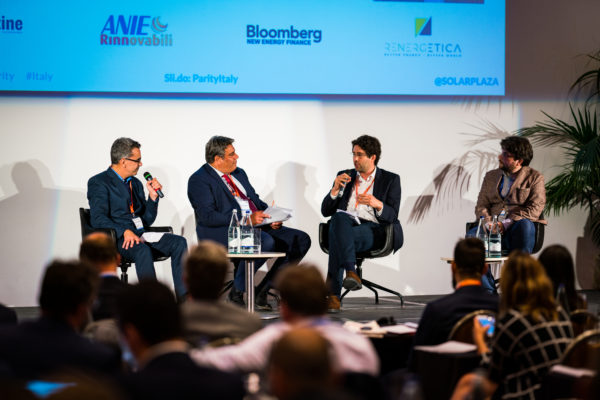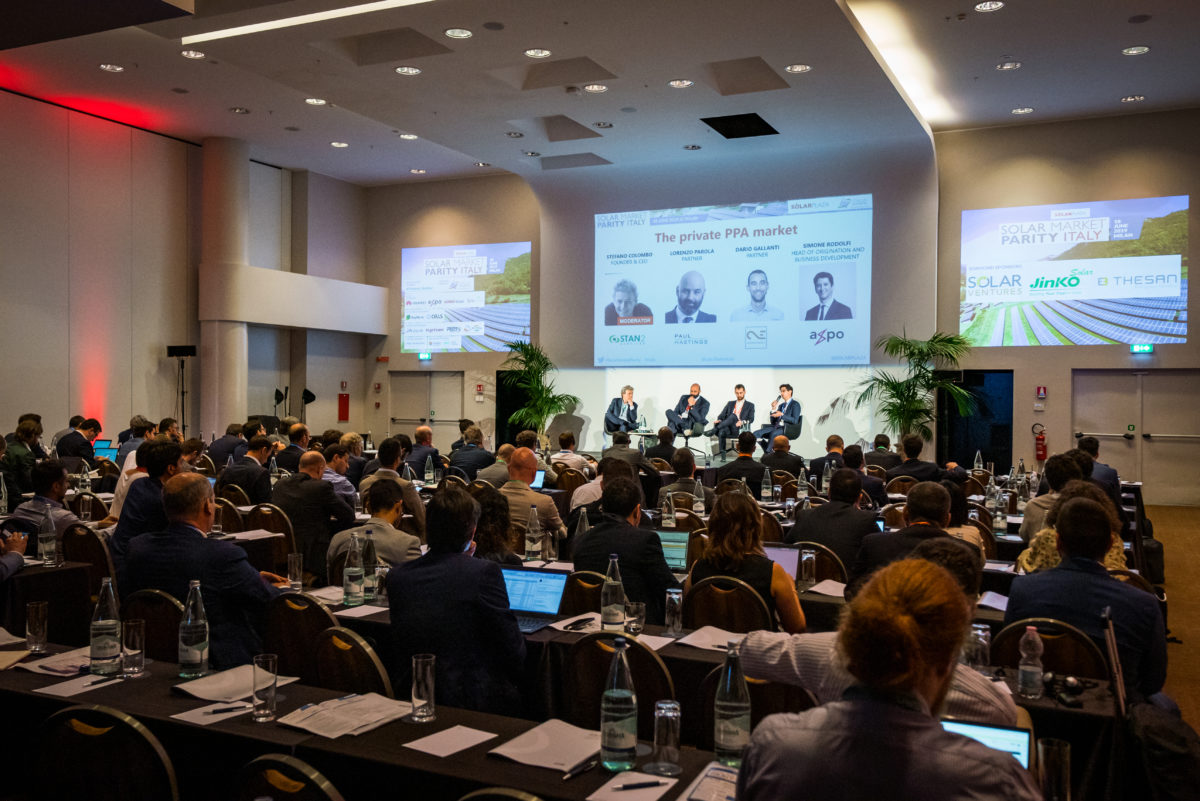The number of participants at this year’s Solar Market Parity Italy event rose from 162 to 192, a change organizer Solarplaza attributed to rising interest for unsubsidized solar and the fact several large scale projects may be connected this year.
Although Italy is unlikely to see the return of a gigawatt-scale market this year it will probably begin to see larger levels of annual deployment than the usual 400 MW, starting from next year when several deals and large scale unsubsidized projects will be completed. In fact, analyst Wood Mackenzie Power and Renewables, in its European Solar PV Market Outlook 2019 report, published today, predicted Italy will be the fifth largest regional solar market, with almost 11.7 GW of new solar capacity expected to be added in the next five years to reach a cumulative 31.8 GW.
Big expectations for subsidy-free Italian projects began to emerge in March 2016, when the first private power purchase agreement (PPA) linked to operational PV was announced by U.K. investment firm Octopus, which had built five “grid parity” solar parks with a combined capacity of 63 MW in Montalto di Castro, in the central region of Lazio. Since then, however, only a few PPAs have been announced with just one more PPA-related project commissioned in Sicily.
Michele Appendino, CEO of Milanese independent power producer Solar Ventures Srl noted at the event only a few players have real projects in hand, with most developers and investors analyzing the dynamics of the unsubsidized solar market. He claimed, however, key players have returned to Italy with resources dedicated to market parity installations. “A lot of capital is available, mainly equity,” he said.
Concrete deals are coming
Appendino was confident that by next June around 500 MW of solar generation capacity may be under PPA, with contract duration increasing from around five years to up to 12 as international brands enter the fray. The Solar Ventures CEO said the attitude of lenders towards grid-parity solar is changing and this time next year we may see more projects financed and credit committees providing feasible financing structures. By the end of next year we may also see the first corporate PPAs signed, the start of stronger activity for development and construction of solar parks in northern Italy and several medium sized projects starting construction.
The chief executive stressed how difficult getting approval from local or national authorities for solar parks in Italy can be. He said highly fragmented procedures and “paper saturation” are common, especially in southern Italy where solar radiation is higher and there is a concentration of large scale projects. Finding sites can also be difficult due to fragmented land ownership and pressure on price. Local communities and authorities often resist solar on agricultural land. Although Italian regulation prevents such opposition for projects granted incentives, that is not the case for PPA-linked facilities.
A weakened government unable or unwilling to impose leadership on local authorities to push for renewables goals offers little support to the sector.
Despite the hurdles, however, Italy is expected to install another 30 GW of solar by 2030 – around 2.5 GW per year.
Virginia Canazza, CEO of Italian consultancy ref4e, solar will miss its 2030 target by reaching approximately 47.6 GW of generation capacity. She believes headwinds may affect market parity conditions including the inefficiency of authorization processes, grid reinforcement, the regulatory framework and storage integration. She estimated the potential demand for PPAs at around 70 TWh, with 25 TWh from corporate buyers, 12 TWh from consortia and 31 TWh from other off-takers. That would correspond to around a quarter of final energy consumption.
Is Italy going merchant?
But unsubsidized solar is not just PPAs, according to Marco Carta, CEO of consultancy Agici Finanza. He said there are one or two solar projects under development financed by full equity which will sell power on the spot market. He did not reveal details as he discussed how a wide variety of business models could be used in the grid-parity solar market in Italy. “It is a risky business, but players with a solid structure may be motivated to follow this path,” said Carta.
In a panel discussing the prospects for solar in the next decade – moderated by pv magazine – Pietro Radoia, solar analyst at BloombergNEF, said Italy will probably reach much more than 50 GW and highlighted 64 GW as a potential milestone, an achievement that took into account technology improvements as well as the potential for reducing the levelised cost of energy. Radoia said the average size of Italian solar parks would be smaller than that of Spain and France, where giant projects are planned.
The panel demonstrated how receptive the Italian PV market is to innovative modules and inverters. A trend towards string inverters is expected over the next decade, according to Alberto Pinori, president of Italian renewable energy association ANIE Rinnovabili and general manager of the Fronius Italia unit of Austrian manufacturer Fronius. As for modules, an increasing interest in bifacial was signaled by Stefano Giuffredi, responsible for business development at Italian renewables company Renergetica, which is returning to the Italian market with unsubsidized projects.
The Solarplaza event reinforced the idea Italy will be one of Europe’s most important PV markets despite a series of issues that must be addressed in the short term.
Politics seems less important for the industry, as illustrated by the lukewarm interest investors and developers showed in an event related to the government’s renewables auctions, the first of which may be launched in September. Analysts believe wind will have the largest share of the procurement and final prices for solar power may be around €50-55/MWh. That auction will also exclude agricultural projects, forcing developers to hunt costly unused surfaces in urban or industrial areas, increasing project costs.
For companies operating in the private PPA segment with large scale schemes, however, auctions may be interesting for the price signals they provide. This would help them identify the niche in which to negotiate PPA prices. And some operators, including Appendino, believe auctions are not absolutely necessary as the market conditions for unsubsidized solar in Italy are already present.
This article was amended on 26/06/19 to include the figures from Wood Mackenzie Power and Renewables’ European Solar PV Market Outlook 2019 report.
This content is protected by copyright and may not be reused. If you want to cooperate with us and would like to reuse some of our content, please contact: editors@pv-magazine.com.




1 comment
By submitting this form you agree to pv magazine using your data for the purposes of publishing your comment.
Your personal data will only be disclosed or otherwise transmitted to third parties for the purposes of spam filtering or if this is necessary for technical maintenance of the website. Any other transfer to third parties will not take place unless this is justified on the basis of applicable data protection regulations or if pv magazine is legally obliged to do so.
You may revoke this consent at any time with effect for the future, in which case your personal data will be deleted immediately. Otherwise, your data will be deleted if pv magazine has processed your request or the purpose of data storage is fulfilled.
Further information on data privacy can be found in our Data Protection Policy.